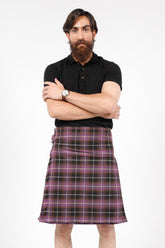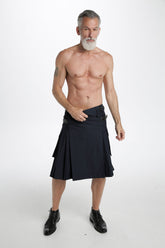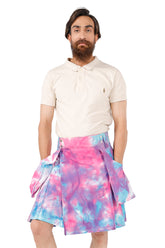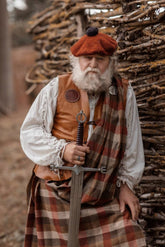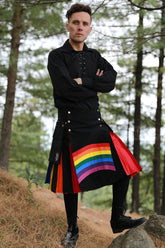Why do Scots Wear Kilts?
Early Origins of the Kilt
The kilt has its origins in the Iron Age (500 BC) among the Celts in Scotland and Ireland. Early forms included "braccae" (woven wool trousers) and "lèine" (a linen or wool shirt). Archaeological finds, like the Falkirk Tartan, showcase early kilt-like garments. The kilt as we know it today originated in the first quarter of the eighteenth century and was known to the Gaelic-speaking Highlander as the “little wrap” (feileadh beag). The tailored plaid kilt was adopted by the Highland regiments of the British Army, and the military kilt and its formalized accessories passed into civilian usage during the early 19th century and have remained popular ever since.
Evolution of the Kilt
The evolution of the kilt can be traced back to the early 1600s when Highlander men wore knee-length thick wool garments over a loose shirt. Over time, this traditional attire gradually changed, giving rise to the 'belted plaid' and the 'little kilt'. The belted plaid, made from double tartan cloth, was wrapped around the body and belted at the waist, with the lower part forming a loose-gathered 'kilt' and the top half worn over one shoulder. The 'little kilt' was made from single tartan cloth, with sewn pleats at the back and plain overlapping pieces at the front, and is the forerunner of the modern kilt.
The popularity of tartan and kilts in the 19th century was partly due to the influence of Scottish writer Sir Walter Scott, who organized a pageant for the newly crowned King George IV of Scotland in 1822. During this visit, King George wore a bespoke highland outfit in bright red tartan, later known as Royal Stuart, or Royal Stewart. This is now the official tartan of Queen Elizabeth II. Today, tartan and kilts are an essential part of Scottish national identity and have become increasingly popular in modern fashion.
Why do Scots Wear Kilts
The kilt is a traditional garment that originated in the Scottish Highlands in the 16th century. It is a knee-length skirt made of woolen cloth that is pleated at the back and worn by men. The reason why Scots wear kilts is rooted in Scottish history and culture. The kilt was originally worn as a practical garment for outdoor activities such as hunting and fighting. It allowed for freedom of movement and was made of durable material that could withstand harsh weather conditions. Over time, the kilt became a symbol of Scottish identity and pride, and it is now worn on formal occasions such as weddings, funerals, and Highland games. So, why do Scots wear kilts? It's a tradition deeply rooted in history, a symbol of endurance, and a celebration of Scottish pride.
How are Scottish Clans Represented Through Plaid Kilt?
Scottish clans are represented through plaid kilts, which feature unique tartan patterns that represent different clans. Tartan, a type of fabric woven with different colored threads in a specific pattern, has been used since the 16th century to create a sense of unity and belonging among clan members. Each plaid kilt has its own unique pattern and color scheme, which helps to identify the identity of the clan or region it belongs to.
Some key aspects of clans and their representation through plaid kilts include:
Origins: Scottish clans started using tartan in the 16th century, and by the 18th century, specific tartan patterns became associated with particular clans.
Purpose: Initially, tartan was used for practical purposes, such as identifying members of a particular clan on the battlefield. However, it later became an important symbol of Scottish identity and cultural heritage.
Colors: The colors used in clan tartans are often inspired by the natural surroundings of the clan's territory, such as the green of the forest or the blue of the nearby loch.
Patterns: There are over 7,000 unique tartans on record, and each clan has its own specific combination of colors and patterns. These tartans are often passed down from generation to generation and are worn with pride by members of the clan.
Tartan Finder: To find your clan's tartan, you can use tools like the Tartan Finder, which allows you to search by name, clan, region, or color. This helps you explore tartans by clan, region, or color, and find the one that best represents your Scottish heritage.
What Type of Kilts are There?
Hybrid Kilt: A hybrid kilt combines traditional Scottish design with modern materials, offering versatility and comfort. It often features pockets and adjustable straps, suitable for various occasions.
Denim Kilt: The denim kilt blends ruggedness with style, providing a contemporary twist to the classic kilt. It's durable and suitable for casual wear, popular among modern kilt enthusiasts.
Utility Kilt: The utility kilt, inspired by workwear, offers functionality with its numerous pockets and durable fabric. It's a practical choice for outdoor activities and everyday wear.
Leather Kilt: The leather kilt exudes a bold and edgy look, often favored by those seeking a distinctive and unconventional style. It offers a unique blend of tradition and modernity.
21st Century Kilts
21st Century Kilts, often referred to as modern kilts, embody a contemporary twist on traditional Scottish attire. Designed for versatility and comfort, these kilts seamlessly blend heritage with modern aesthetics. Crafted from diverse materials such as denim, leather, and lightweight fabrics, they cater to a dynamic range of occasions, from casual wear to formal events. Embracing innovation, 21st Century Kilts often feature adjustable fastenings and functional pockets, enhancing practicality. Popularized by fashion-forward individuals seeking a distinctive alternative to traditional kilts, this contemporary adaptation reflects a fusion of culture and style, redefining the iconic garment for the demands of the modern era.
Cultural Significance & Occasions for Wearing Kilts
Kilts, emblematic of Scottish heritage, hold profound cultural significance and are worn on various occasions. Rooted in Scotland's rich history, scottish kilt was originally everyday attire for Highlanders and have evolved into a symbol of national pride. Primarily associated with formal events like weddings, graduations, and ceilidh dances, kilts convey a sense of tradition and dignity. The choice of tartan, with its distinctive patterns representing different clans, adds a personal touch to these occasions. Beyond formal events, modern interpretations have expanded the kilt's versatility, making it suitable for casual wear, festivals, and even fashion statements. The enduring allure of kilts lies in their ability to seamlessly blend tradition with contemporary style, fostering a timeless connection to Scotland's cultural tapestry.
Can you Wear a Kilt if you are not Scottish?
It is generally acceptable for non-Scots to wear a kilt as long as it is done with respect and for legitimate reasons. The kilt is known as the national dress of Scotland and holds cultural significance to the Scots, especially highlanders. While there are no strict rules on who can wear a kilt, it is important to avoid wearing it as a joke or to make fun of Scottish culture. The consensus among Scots is that they are more concerned about when the kilt is worn rather than who is wearing it. Wearing a kilt at appropriate events, such as Highland Games, Special festivals of Scotland, weddings, or as a celebration of Scottish heritage, is generally well-received. Ultimately, the decision to wear a kilt should be based on individual preferences and cultural beliefs, and it is important to wear it with pride and respect for Scottish culture.
Kilt Up!
When it comes to traditional Scottish attire, Fashion Kilt offers a modern twist on the classic Scottish kilt. Embrace your heritage with high-quality fabrics and stylish designs that are perfect for any occasion. Whether you're attending a formal event or simply want to make a fashion statement, We have you covered. Emphasize the elegance and timelessness of the Scottish kilt, and its versatility as a wardrobe essential. Elevate your style with our exquisite collection of kilts.
FAQs
What is the history of the Scottish kilt?
The Scottish kilt has a long history dating back to the 16th century. The first kilt was the great kilt, which was a full-length garment that could be worn as a cloak, pulled up over the head or draped around the shoulder. Prior to the development of the kilt as we know it today, there was an item of clothing known as a “brat” or woolen cloak (also known as a plaid) which was worn by the Highlanders.
What is proper to wear with a kilt?
The traditional Scottish kilt is usually worn with a sporran, a type of pouch worn around the waist, a kilt pin, and a sgian-dubh, a small knife worn in the sock. Other accessories may include a jacket, waistcoat, and tie.
What is the difference between a traditional kilt and a modern kilt?
Traditional kilts are made using heavy (16 oz) weight fabric, while modern kilts are sometimes made with lighter-weight tartans and different fabrics, like denim. Modern kilts are also sometimes called utility kilts and usually come with cargo pockets (which are sometimes detachable) so you don’t need to wear a sporran.
Are all kilts the same, or do they have different meanings?
Kilts can vary in pattern and color, known as tartan, which often represents a particular Scottish clan. Each clan has its unique tartan, and wearing a specific tartan can be a way of showing allegiance to a particular family or group.
Is it appropriate for non-Scots to wear kilts?
It is acceptable for non-Scots to wear kilts. Many people of Scottish heritage and even those with no Scottish ancestry choose to wear kilts to celebrate Scottish culture at events like weddings, Highland games, or other special occasions.

